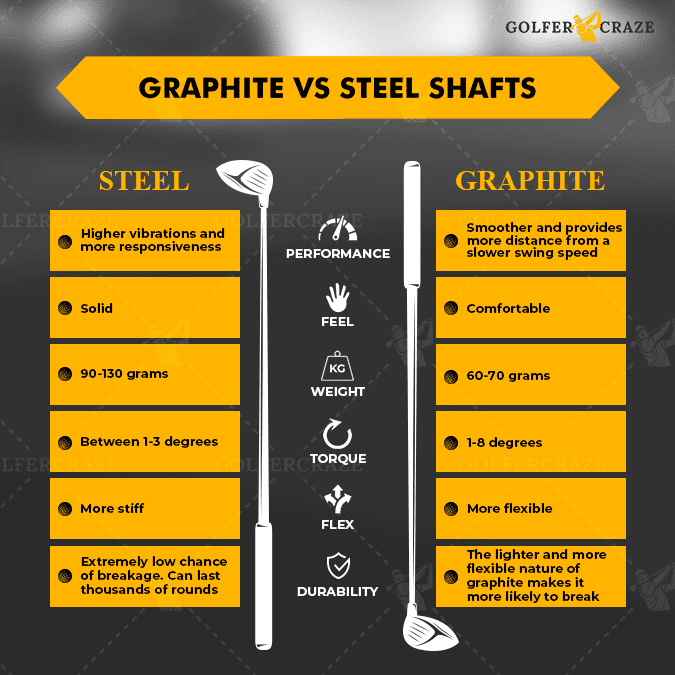Graphite Vs Steel Shaft: Which Is Better To Buy?

No matter your experience level, picking the right set of irons with graphite or steel shafts can be difficult. Here, we explore the similarities and differences between them to help you make an informed decision.
Golf shafts play an important role in the game of golf, as they are integral to accuracy and distance. With so many choices available on the market, choosing between graphite vs steel shaft can be challenging.
Graphite shafts offer more flexibility and lighter weight than steel but may not be as strong or durable. Ultimately, which option is best for you depends on many other factors.
I. The difference: graphite vs steel shaft
There are two types of golf shafts to choose from- steel or graphite shafts. Both graphite and steel shafts come with unique features, benefits, and drawbacks.
However, to select the best golf shaft for your needs, you should know the differences and how they can affect your game.

1. Weight
Graphite iron shafts are lighter than steel iron shafts, which makes them easier to swing. This is beneficial for golfers who have slower swing speeds. On average, graphite shafts’ weight ranges from 60-70 grams, whereas steel shafts are heavier and weigh about 90-130 grams.
2. Feel
Feel is another decision-making factor when it comes to graphite vs. steel shafts. Graphite shafts tend to have a comfortable feel, while steel shafts can be stiffer or more solid. However, steel shafts offer more feedback to the golfer than graphite shafts.
3. Flex point
Shaft flex is a measure of how much the shaft bends when hit. Graphite shafts are usually more flexible, which can help improve your ball launch and spin. On the other hand, steel shafts are typically stiffer and offer more stability and control.
4. Torque
“Torque” is a golf shaft term that refers to how much the shaft will twist during the golf swing. And it is measured in degrees. A graphite shaft has 1-8 degrees of torque, while a steel shaft has 1-3 degrees of torque. Generally, fast swingers prefer steel shafts with lower torque because they offer more stability and control during the swing.
5. Performance
Performance of the graphite and steel shafts will vary based on the individual golfer’s swing speed, strength, and playing style. However, graphite shafts provide more distance, and have a smoother and more comfortable feel, while steel shafts vibrate more upon impact with the golf ball.
6. Durability
Durability is another factor to consider when choosing graphite vs. steel shafts. Graphite shafts are more flexible and can bend or break with repeated shots. However, with advancements in technology, graphite shafts are now more durable than ever. On the other hand, steel shafts are durable and last longer but can be susceptible to rust.
II. Similarities between the steel and graphite shafts
Like differences, graphite and steel shafts also share a few similarities. Here are a few similarities between graphite and steel shafts:
- Both graphite and steel shafts are available in a range of kick points.
- All levels of golfers can use graphite and steel shafts.
- Both graphite and steel shafts are available in a variety of lengths and weights.
III. Why picking the right shaft is important for your game?
A right shaft makes a huge difference in your game. Here is how a right shaft can help you to improve your game:
- Helps you to hit the ball farther, straighter, and with more control.
- Helps to create an optimal launch angle and spin rate for better accuracy.
- Helps reduce fatigue, allowing you to play longer and more consistently.
- Helps to maximize clubhead speed for maximum distance.
IV. Who should use steel golf shafts?
Here is a list of people who should consider steel golf shafts:
- Golfers with slower swing speeds.
- Golfers who prefer a firmer feel and more feedback.
- Golfers who need more stability and control during their swing.
V. Who should use graphite golf shafts?
Here is a list of golfers who should consider graphite golf shafts:
- Beginner and high-handicap golfers who want to generate more swing speed
- Golfers who need a higher launch angle
- Golfers who prefer a smoother feel
- Golfers with neck, shoulder, and back problems who need lighter clubs.
VI. Pros and cons of graphite and steel shafts
Here is a quick glance at the pros and cons of graphite vs. steel shaft:
Pros
| Graphite shafts | Steel shafts |
| Lighter and easier to swing | Affordable |
| More club speed | Accuracy |
| Creates more spin | Better feedback |
| Higher ball flight | Durable |
Cons
| Graphite shafts | Steel shafts |
| Expensive | Heavy |
| Not suitable for fast swingers | Stiffer grip |
| Comparitvely less durable | Difficulty in releasing the golf club |
VII. Which type of shaft should beginners use?
Lighter graphite shafts are ideal for beginner golfers. Although a graphite shaft is expensive, it is the best choice for beginners due to its lightweight and flexible nature. Graphite shafts help beginner golfers to generate more clubhead speed, which eventually results in more distance.
VIII. Shaft type for different golf clubs
Different types golf clubs require different types of shafts. Here is a list of shaft types for different golf clubs:
1. Shaft type for irons
For high handicaps and beginner golfers, graphite iron shafts are recommended. For low handicap and scratch golfers, a steel shaft can be a great option.
2. Shaft type for drivers
Unless you have extra speed, graphite shafts are recommended for drivers. As drivers are typically designed to hit the ball farther, graphite shafts can help to generate more clubhead speed and achieve the desired distance.
3. Shaft type for fairway woods
Golfers use fairway woods to strike the ball over great distances. Thus, graphite shafts are preferred over steel to meet the swing speed and launch speed requirements.
4. Shaft type for wedges
Wedges are used for shorter and more accurate shots. As steel shafts provide control and accuracy, steel shafts are recommended for wedges.
5. Shaft type for putters
Putters are used for short and low-speed strokes in golf. Thus, steel shafts are recommended for putters to achieve a consistent and smooth stroke.
Conclusion
The right shaft can help you to enhance your performance and improve accuracy. Both graphite and steel shafts come with pros and cons. Ultimately, the choice between graphite and steel shafts depends on a golfer’s swing speed, feel preferences, budget, and other factors.








